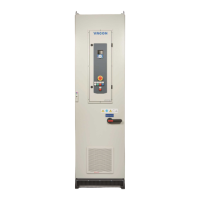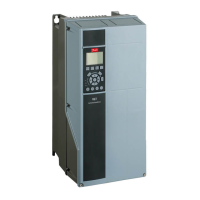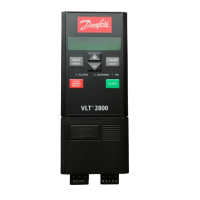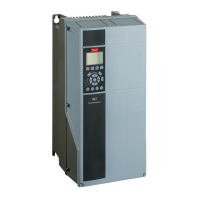
Do you have a question about the Danfoss VACON OPTEA and is the answer not in the manual?
Describes the manual's purpose for VACON® Advanced Safety Options used with VACON® NXP AC drives.
Lists available resources, manuals, standards, and software for the drive and option boards.
Details manual revisions, new features, firmware, and hardware versions.
Presents the TÜV certificate and EC Declaration of Conformity for the VACON® Advanced Safety Option Card.
Introduces safety functions (STO, SS1, SS2, etc.) and supported safe fieldbuses.
Defines abbreviations and terms used in the manual for clarity and understanding.
Explains safety symbols used in the manual for hazard indication.
Details hazardous situations, including shock hazards from components and terminals.
Provides cautions regarding drive damage from incorrect measurements, spare parts, or grounding.
Explains grounding requirements for the AC drive according to standards and directives.
Describes how the Advanced Safety Option board implements safety functions and its integration with the AC drive.
Defines the safe state and how it's achieved, typically with Safe Torque Off (STO).
Discusses the system designer's responsibility for integration, risk assessment, and interfaces.
Explains how to determine the safety level, considering the whole safety chain.
Details supported slots for option board revisions and available connectors.
Explains the configuration of the 4 two-terminal digital inputs for safety functions.
Details the configuration of the 2 two-terminal digital outputs for safety functions and custom logic.
Describes the OPTBL option board for use without an encoder for speed measurement.
Details the OPTBM option board with a digital pulse TTL/HTL encoder interface for closed-loop control.
Describes the OPTBN option board with a Sin/Cos type encoder interface for closed-loop control.
Explains how to use OPTBM for closed-loop control, noting features and differences.
Details using OPTBN for closed-loop control, including features and differences.
Lists supported safety speed sensors like Sin/Cos encoder, digital pulse encoder, and proximity sensor.
Shows achievable safety levels with different speed sensor combinations without certificates.
Discusses the behavior when speed values from multiple sources exceed allowed deviation.
Explains the encoder interface boards, signal connections, and closed-loop control usage.
Details connecting two proximity sensors to the safe I/O for speed measurement.
Explains how the board verifies encoder signal correctness and diagnostic coverage.
Discusses fault models to consider when using a single speed sensor.
Recommends using estimated speed as a second channel for diagnostics.
Explains setting the ratio between sensor speed and estimated speed for gear systems.
Analyzes consequences of estimated speed usage with external forces.
Explains parameter backup locations on the option board, control board, and PC.
Provides instructions to store a parameter file backup from the Advanced Safety Option.
Gives instructions to restore a parameter file from backup to the Advanced Safety Option.
Lists required drive component versions for using the Advanced Safety Option board.
Discusses compatibility of the Advanced Safety Option board with drive applications.
Explains how to use the control panel menu to manage the option board.
Classifies faults (critical, resettable, violation, warning) for the Advanced safety option board.
Provides warnings before installing the option board, including shock hazards.
Gives step-by-step instructions for installing the option board in VACON® NXP drives.
Lists the functions of the VACON Safe tool for parameterization and monitoring.
Explains parameter files, their states (unverified, verified, validated), and transfer.
Describes the two-level password system (Admin, Service) for parameter protection.
Details the 4-step process for parameterizing the Advanced safety option board using VACON Safe.
Instructions for saving a verified parameter file to the option board.
Explains how to view the status and execution of safety functions and I/O via VACON Safe.
Categorizes safety functions into safe stopping and safe monitoring functions.
Describes the three states of safety functions: inactive, active, and reached.
Explains how safety functions are activated via digital inputs or safe fieldbus.
Details causes of violations and the two types of violation responses.
Explains how to acknowledge safety functions (automatic/manual) and their sources.
How acknowledgment signal permits STO release after start-up.
Explains using reset signals to deactivate STO and reset faults.
Describes ramp monitoring for safety functions and parameterization options.
Introduces safe stopping functions that stop and monitor motor stopping.
Introduces Safe Torque Off (STO) and Safe Brake Control (SBC) functions.
Explains STO activation when SBC is not used.
Details STO and SBC behavior based on SBC parameters and order.
Describes the activation and deactivation signals for STO and SBC functions.
Introduces SS1 function for monitoring motor deceleration and activating STO(+SBC).
Explains the Time Monitoring mode for SS1, including STO activation and SBC Speed.
Details Zero Speed Monitoring for SS1, including STO activation and SS1 td2.
Describes Ramp Monitoring for SS1, including parameter selection and violation response.
Details the activation and deactivation signals for the SS1 function.
Introduces SS2 for motor deceleration and SOS for monitoring motor shaft position.
Explains Time Monitoring for SS2, including SOS activation and SS2 t1.
Details Zero Speed Monitoring for SS2, including SOS activation and SS2 td2.
Describes Ramp Monitoring for SS2, including parameter selection and violation response.
Explains the SOS function for monitoring shaft rotation and its deviation limits.
Details the activation and deactivation signals for SS2 and SOS functions.
Introduces SQS function with modes SQS-STO, SQS-SS1, SQS-SS2 and its violation response.
Explains SQS modes (STO, SS1, SS2) and their behavior relative to independent functions.
Details the activation and deactivation signals for SQS functions.
Introduces functions monitoring speed, position, or acceleration, often without direction consideration.
Explains SLS for monitoring motor speed against limits and its deceleration monitoring.
Explains SLS for monitoring motor speed against limits and its deceleration monitoring.
Details Time Monitoring for SLS, including SLS t1 and violation response.
Describes Ramp Monitoring for SLS, including parameter selection and violation response.
Explains how SLS selects speed limits from digital inputs or fieldbus based on priority.
Details the activation and deactivation signals for SLS functions.
Introduces SMS for monitoring motor speed against parameterized limits, independently for rotation directions.
Introduces SMS for monitoring motor speed against parameterized limits, independently for rotation directions.
Explains how maximum speed monitoring starts and operates when SMS is active.
Details the activation and deactivation signals for SMS functions.
Introduces SSR for monitoring motor speed within a parameterized range (max/min).
Introduces SSR for monitoring motor speed within a parameterized range (max/min).
Details Time Monitoring for SSR, including SSR t1 and violation response.
Describes Ramp Monitoring for SSR, including parameter selection and violation response.
Details the activation and deactivation signals for SSR functions.
Introduces SSM for signaling motor speed within set limits, with a safe output.
Introduces SSM for signaling motor speed within set limits, with a safe output.
Explains maximum and minimum speed monitoring for SSM, and disabling monitoring.
Describes how the SSM safe output state is determined by motor speed and function activity.
Details the activation and deactivation signals for SSM functions.
Discusses how multiple active safety functions monitor limits and potential unexpected violations.
Introduces PROFIsafe as a safety protocol over PROFIBUS/PROFINET, ensuring communication validity.
Lists required components and versions for using PROFIsafe with the Advanced safety option board.
Illustrates the PROFIsafe system architecture with safety PLC and VACON NXP components.
Describes the structure of the PROFIsafe frame, including I/O data and CRC.
Details PROFIsafe parameter requirements and cyclic communication for safety.
Details PROFIsafe parameter requirements and cyclic communication for safety.
Explains the F-Parameter F WD Time for determining watchdog time.
Defines SFRT and provides formula for calculation.
Discusses PROFIdrive on PROFIsafe compatibility and drive application usage.
Discusses PROFIdrive on PROFIsafe compatibility and drive application usage.
Explains PROFIsafe data structure in PROFIBUS messages.
Describes PROFIsafe data placement in PROFINET slots.
Details telegrams used for controlling AC drive safety with PROFIsafe.
Describes the bits and signals in Safety Control Word 1.
Explains Safety Status Word 1 used with S_STW1 for Standard Telegram 30.
Describes Safety Control Word 2, offering more safety functions and SLS limit selection.
Explains Safety Status Word 2 for Standard Telegram 31, including SLS limits and SSM status.
Defines the vendor-specific VACON Safety Control Word for full fieldbus access.
Describes VACON Safety Status Word for input data and function statuses.
Lists parameters for file name, creator, date, company, and comment.
Defines common parameters for safety functions like Zero Speed and Drive Acknowledgment.
Lists parameters for selecting encoder type, power supply, and signal settings.
Lists parameters for defining acceleration and deceleration ramps for safety functions.
Lists parameters related to estimated speed, like Coast Stop Time.
Details parameters for configuring digital inputs and outputs for safety functions.
Lists PROFIsafe specific parameters like fieldbus type, source, destination, and watchdog time.
Defines parameters for STO and SBC functions, including acknowledgment mode and speed settings.
Lists parameters for SS1 function, including acknowledgment mode, monitoring, ramps, and timing.
Defines parameters for SS2 and SOS functions, including acknowledgment mode, monitoring, and ramps.
Lists parameters for SQS function, including acknowledgment mode, type, monitoring, and timing.
Details parameters for SLS function, including acknowledgment, ramps, timing, and speed limits.
Lists parameters for SMS function, including acknowledgment mode and speed limits.
Defines parameters for SSR function, including acknowledgment, ramps, and speed limits.
Lists parameters for SSM function, including acknowledgment mode, always active, timing, and speed limits.
Lists parameters for validating the system, including tester name, company, date, and comment.
Provides information and steps for preparing the commissioning process.
Lists procedures to follow before the initial system start-up with the option board.
Outlines steps for the initial start-up after installing the option board.
Provides a checklist to verify correct installation and parameterization of the option board.
Explains how to validate the parameter file stored in the option board using VACON Safe.
Lists conditions that must be met before the system can be put into use.
Warns about bypassing safety features and advises careful consideration.
Lists sources for gathering diagnostic data for troubleshooting and support.
Recommends periodic testing for certain components and states requirements for safety levels.
Explains how to reset passwords using the control panel or factory reset.
Details the factory reset procedure for the option board and its effects.
Guides on updating the option board firmware, including precautions and tools.
Provides a procedure for updating the option board firmware using VACON Loader.
Gives instructions for replacing the option board, including safety precautions and parameter management.
Advises considering effects of changes to other safety system components.
Provides guidelines for disposing of the option board and its components responsibly.
Lists general safety characteristics like SIL, PL, and HFT for the option board variants.
Details the specifications for safe input and output data, including voltage, current, and debounce times.
Compares speed sources and their allowed deviations.
Provides technical data for Sin/Cos encoders, including voltage, current, and frequency.
Lists technical data for Digital Pulse encoders (HTL, TTL), including voltage and signals.
Details technical specifications for proximity sensors, including supported types and operating frequency.
Provides details on supported motor types and estimation error for estimated speed.
Lists data related to safe fieldbus communication, including protocols and telegrams.
Provides environmental data for operating and storing the AC drive and option board.
Explains the syntax and fields used for presenting faults on the control panel and PC tools.
Details various fault codes (F20, F8, F46, F47, F48) and their causes/troubleshooting.
Introduces configuration examples for different safety functions, emphasizing system preparation.
Provides an example configuration for emergency stop using STO with OPTBL and OPTAF.
Details a configuration example using SS1 with STO(+SBC) in OPTBL for ramp control.
Explains SLS speed limiting using external frequency reference when drive app lacks support.
Describes a configuration using SQS-SS1 and SLS with a light curtain for motor control.
Explains SLS speed limiting using external frequency reference when drive app lacks support.
Shows a configuration using SLS and SQS with an output to control an external door lock.
Details a configuration for PROFIdrive over PROFIsafe using OPTBN/OPTEA with STO, SS1, SLS, SQS.
Presents a configuration example using one proximity sensor for speed measurement with OPTBL.











